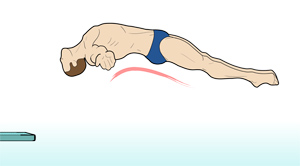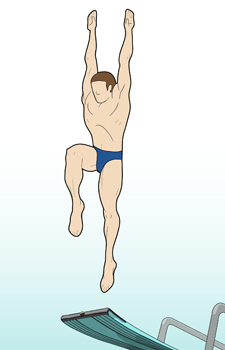How to Do a Reverse Dive
January 22, 2024


One of the things most divers fear when first starting out is hitting their head on the diving board. Nowhere is that fear more evident than in learning how to do a reverse dive. Reverse dives, otherwise known as gainers, are when a diver faces forward and then does a backward-motion dive or somersault.
Almost everyone has heard of, or seen someone, hit their head on a diving board while attempting a reverse dive. Who can forget the 1988 Olympics, where Greg Louganis, performing a reverse 2½ somersault pike on the 3-meter in the qualifying round, hit his head on the board. He received stitches on the side of the pool and continued diving, qualifying for the finals, and actually walking away with the gold medal. These accidents do occur even to incredible divers such as Louganis.
However, there are ways to learn the dive safely. Key factors such as proper take-off, good arm positioning, head positioning and body alignment, will make the difference between a dive that is fun and one that sends chills through the body.
Jump First Then Dive
When learning how to do a reverse dive, the best way to start is with the standing jump.
.jpg)
When the body enters the water, the arms should be straight above the head with the head in line with the body. Continue practicing this skill until it feels comfortable.
"V" Sit Position
The next step may sound odd. Still standing on the edge of the deck, jump into the water the way explained above, but this time land on your bottom, in a "V" shaped position - the legs can be in a tuck or pike position. This motion will set up the rotation required for a dive.
The body position in this jump is vital. Here are some things to keep in mind:
- The arms swing in a counterclockwise direction and the head is in line with the arms.
- Do not throw the head back, as this will bring the body back towards the deck.
- The legs should jump out away from the deck with the feet leading the direction.
After practicing this skill for a while, move the jump up to the 1-meter springboard.
Advance to the Springboard
Just as you did on the side of the deck with the bottom "V" jump, stand at the edge of the diving board and do the same thing. With a good jump out away from the board, initiate the bottom "V" jump just as it was done off the side of the pool.
A common desire when learning to do a reverse dive is to jump out with the hips leading the way. This is called "hipping a dive" and can actually cause the body to thrust toward the diving board. By taking a good jump away from the board, with feet leading the way, a reverse dive can be performed safely.
The 1-meter springboard is three feet off the water and therefore the top of the "V" jump will be much higher than it was when performed off the side of the deck. When at the top of the "V" jump with the legs either in the tuck or pike position, unfold the top half of the body backwards towards the water and dive in.
Again, the body position is critical. The arms swing in a counter-clockwise direction and finish up by the ears. The head stays in line with the arms and the legs jump out away from the diving board with the feet leading the way. At first, the dive may land short of vertical, but that is OK. The goal is to land in the water with the head entering first.
The Hurdle in a Reverse Dive

In the Fundamentals of Diving guide, the hurdle is discussed and stressed as one of the most important skills in diving. Here in reverse dives, that skill is put to the test. After learning and practicing the dive in the standing position, it is time to add the hurdle. Body alignment, arm positioning, and landing on the board in the correct spot are crucial with reverse dives. The hurdle will provide the dive with momentum and height.
Here is how to do a reverse dive with a hurdle:
A good jump away from the board will provide the safe distance needed in this dive. A solid and forceful arm movement, with the head in line with the body, will provide the momentum needed to complete the dive.
Use Caution
Please keep in mind that a reverse dive is a skill that should not be practiced alone, nor should it be practiced in a recreational manner. An experienced coach or diver should assist a novice diver in the skill. Reverse dives require respect. Even the very best divers, such as Louganis, hit the board occasionally. In hopes of preventing this from happening, body alignment and a good take-off cannot be stressed enough.



